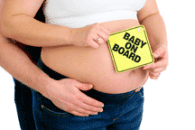8 Signs That Labor is Near
As you near the end of your pregnancy, you are likely anxious to meet your new little one and are feeling the discomfort of the last days of pregnancy (See 16 Ways to Help Labor Progress and Understanding The Stages of Labor). Here are signs that labor is near to watch for as you anticipate your baby’s arrival.
1. Dropping
Some time during the final few weeks one of the signs that labor is near you may notice is that your baby has moved down lower in your abdomen. Most first-timers notice their babies dropping within two weeks of delivery. However, some mothers “drop” as many as four weeks before D-day (delivery day). Second-time mothers often find their babies do not drop lower until labor begins. This is because mom’s pelvic muscles have already been stretched, and no warm-up is needed. Baby’s head settling into the pelvis is also called “lightening” (because the lower-riding load seems smaller and lighter). Another term is “engagement” (since baby’s head engages the pelvic opening). Whether baby “drops,” “lightens,” or “engages,” you will feel and look different. Your breasts probably no longer touch the top of your abdomen. You might be able to sense baby’s head resting just beneath the middle of your pelvic bone.
2. Frequent Urination
Now that baby’s head lies closer to your bladder you may be going to the bathroom more often. While frequent trips to the restroom are a nuisance, it’s a detectable sign of labor.
3. Low Backache
As baby gets heavier and drops lower, count on some aches or pains in your lower back and pelvis as your uterine and pelvic ligaments are stretched in even more.
4. Stronger Braxton-Hicks Contractions
One of the undeniable signs that labor is near is your warm-up contractions go from feeling uncomfortable to being rather painful like menstrual cramps. Even though these pre-labor contractions are not as strong as labor contractions, they are strong enough to be starting the work of thinning out, or effacing, your cervix from a thick-walled cone to a thin-walled cup. While these contractions will get even stronger just prior to labor, they can continue this way, on and off, for a week or two before labor starts. They become less intense when you change position or start walking.
5. Diarrhea
Birth hormones will give you signs that labor is nearby acting on your intestines. This may cause abdominal cramps and loose, frequent bowel movements — nature’s enema, emptying your intestines to make more room for baby’s passage. Those same hormones can also make you feel nauseated.
6. Increased Vaginal Discharge
You may notice more egg white or pink-tinged vaginal discharge. These signs that labor is near are different from the “bloody show.”
7. Bloody Show
The combination of baby’s head descending into the pelvic cavity and the pre-labor contractions thinning the cervix can “uncork” the mucus plug that previously sealed the cervix. The consistency of this mucus varies from stringy, to thick and gooey. Some women notice the one-time passing of an obvious mucus plug; others simply notice increased blood-tinged vaginal discharge. Some of the tiny blood vessels in your cervix break as your cervix thins, so you may see anything from a pink to a brownish-red-tinged teaspoonful of bloody mucous. If your discharge shows more blood than mucus – like a menstrual period or a lot of bright-red blood — report this to your practitioner immediately. Once you notice a bloody show, you are likely to begin labor within three days, but some mothers hang on for another week or two.
8. Bag of Waters Breaking
Only 1 in 10 mothers experience their bag of waters breaking prior to labor. For most mothers, this doesn’t happen until they are well into labor. If your water breaks before labor has started, plan on your labor starting intensely within the next few minutes or hours, or at least within the next day.
Related literature from The Sears Parenting Library:
The Healthy Pregnancy Book: Month by Month, Everything You Need to Know from America’s Baby Experts
The Birth Book: Everything You Need to Know to Have a Safe and Satisfying Birth
Dr. Sears, or Dr. Bill as his “little patients” call him, has been advising busy parents on how to raise healthier families for over 40 years. He received his medical training at Harvard Medical School’s Children’s Hospital in Boston and The Hospital for Sick Children in Toronto, the world’s largest children’s hospital, where he was associate ward chief of the newborn intensive care unit before serving as the chief of pediatrics at Toronto Western Hospital, a teaching hospital of the University of Toronto. He has served as a professor of pediatrics at the University of Toronto, University of South Carolina, University of Southern California School of Medicine, and University of California: Irvine. As a father of 8 children, he coached Little League sports for 20 years, and together with his wife Martha has written more than 40 best-selling books and countless articles on nutrition, parenting, and healthy aging. He serves as a health consultant for magazines, TV, radio and other media, and his AskDrSears.com website is one of the most popular health and parenting sites. Dr. Sears has appeared on over 100 television programs, including 20/20, Good Morning America, Oprah, Today, The View, and Dr. Phil, and was featured on the cover of TIME Magazine in May 2012. He is noted for his science-made-simple-and-fun approach to family health.

